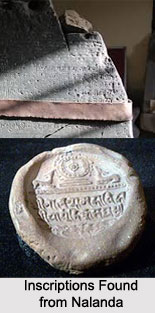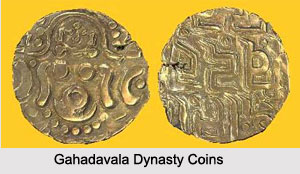 Inscriptions in Nalanda that are found after unearthen in the Biritish era shows the clear picture of the civilised Indian society in the early era of 4th, 5th, 6th and 7th Century.
Inscriptions in Nalanda that are found after unearthen in the Biritish era shows the clear picture of the civilised Indian society in the early era of 4th, 5th, 6th and 7th Century.
Excavations of Nalanda
The Nalanda inscription is an inscription located in Nalanda, Bihar and has been dated to 860 AD. The inscription talks about king Devapaladeva of Bengal who had granted the request of Sri Maharaja of Suvarnadvipa, Balaputra, to build a Buddhist monastery at Nalanda. Balaputra was mentioned as the son of Samaragrawira, grandson of Sailendravamsatilaka (the jewel of the Sailendra family) with stylized name Sriviravairimathana (the slayer of enemy hero), king of Java that married Tara, daughter of Dharmasetu.
Monastery Site 1 yielded three copper-plate inscriptions belonging to Samudragupta (circa335-75), Dharmapala circa 770-819) and Devapala (circa 810-59) respectively. Ihe copper-plate of Dharmapala records the grant in the district (Vishaya) of Gaya
in the Nagara (Patna) vision (bhukti). The copper-plate of Devapala is much more important. The original copper-plates are now in the Indian museum.
Stone Inscriptions of Nalanda Excavations
There are the stone inscriptions, both of which are very important, are now in the Nalanda Archaeological Museum.
1. The inscription of the time of Yasovarmadeva, recording various gifts, including a permanent grant to the temple erected at Nalanda Monastery by king Baladitya, by Malada, the son of a minister of king Yasovarmadeva, evidently the renowned king of Kanauj of the first quarter of the eighth century.
2. Inscription of Vipulasrimitra, recording the activities of the ascetic Vipulasrimitra, who, among other things, built a temple of Tara, adorned with a court and tank, at Somapura, where he resided for a long time and renovated a local monastery. At Nalanda he erected a monastery, an ornament of the world, surpassing in a wonderful manner the palace of Indra, and made it over to the line of ascetics to which he belonged. The inscription was recovered from the uppermost level of Monastery Site 7, which have already seen shows three periods of occupation. On the basis of this inscription one may ascribe the construction of the uppermost monastery to the first half of the twelfth century to which the inscription may be referred on palaeographical considerations.
Brick Inscriptions of Nalanda Monastery
There are many brick inscriptions, mostly fragmentary, have been discovered from the core of the small votive stupas attached to the main temple of Nalanda. The inscriptions give the Buddhist creed, dharma, etc., or the more elaborate Nidana-sutra or Pratityasamutpada-sutra, with or without the nirodha portion. This sutra is found in
many Buddhist texts, both in Sanskrit and Pali language.
Seals and Plaques from Nalanda Monastery
The vast number of seals and plaques discovered at Nalanda Monastery fall under two categories: 1. Ecclesiastical Seals and 2. Civil Seals. Under the former head come those seals which bear the Buddhist creed, sometimes with the figure of Buddha, or bear only the image of Buddha without any other stamp. Of the secular sealing, historically the most important are those which belong to royal personages, such as Narasimhagupta and Kumaragupta II of the Gupta dynasty, Sarvavarman and Avantivarman of the Maukhari dynasty, Supratishthitavarman and Bhaskaravarman of Assam, Harshavardhana of Kanauj, and Pasupatisimha, Devasimha and Isanasimha of an unknown lineage. The Civil sealing gives a vast number of names. There are also seals of particular offices, such as the Office Of The Kumaramatya in the Magadha division (Bnhukti), Office
Of Gaya District (Vishaya), Office of the Rajagriha district, Office of the Kumaramatya of the Nagara (Patna) division.
Coins of Nalanda Monastery
The coins of Nalanda Monastery that are found at Nalanda archaeological site include those of Kumaragupta I and Narsimhagupta of the Gupta lineage, Sasanka of Bengal
Adivaraha or Bhoja I of the Pratihara dynasty and Govindachandra of the Gahadavala dynasty. All of these are now preserved in the Indian Museum of Kolkata, West Bengal.



















